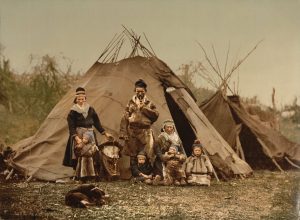Why Sámi?
The term “Sámi” refers to some nine very closely related languages belonging to the Finno-Ugric language family and spoken by the indigenous people of Finland, Norway, Sweden, and the Kola Peninsula of the Russian Federation. With some 20,000 speakers, Northern Sámi is the most widely spoken of these languages, followed by Lule Sámi, which has some 2000 speakers. Overall some 30,000 people speak Sámi languages. Given that roughly 80,000 people identify as Sámi today, these numbers reflect a long history of state suppression of Sámi language and culture, which only began to be reversed in the latter half of the twentieth century. Today, Sámi are recognized as indigenous in the constitutions of Finland, Norway, and Sweden, and the maintenance, preservation, and further development of Sámi languages are stated goals of legislation in all three of these Nordic countries. The Sámi of the Kola Peninsula are not as enfranchised as their Nordic counterparts but have developed strong institutions and activism of their own. The Sámi work hard to bridge national boundaries imposed upon them by colonizing governments.
The Sámi languages are interesting to students of culture for a variety of reasons. First, Sámi incorporates a large number of “substrate” terms which derive from a language spoken by the very first inhabitants of the Nordic region after the last Ice Age, some 13,000 years ago. Terms for things like walrus (morša), the snow bunting (állat), and a bridge of ice that forms over a river during winter (cuokca) reflect the intimate knowledge of the environment these ancient inhabitants shared with the Finno-Ugric speakers who arrived in the region around 6000 years ago. Second, Sámi language has developed nuanced vocabulary for ideas and activities that were important to Sámi over the millennia. Terms for different kinds of movement, varieties of reindeer body and horns, and types of snow are wonderfully elaborate and refined, and reflect the great depth of traditional knowledge that Sámi people developed and maintained over many centuries. Thirdly, the Sámi languages reflect close contacts with Finnish and Scandinavian languages over time, with many loanwords and phonological influences passing both into and out of the Sámi langauges. And finally, the Sámi languages remain active idioms today: used for composing modern poetry, writing novels and screenplays, and increasingly, drafting formal academic treatises and articles.
The Sámi have been leaders in indigenous rights. They have played important roles in striving for the rights of indigenous peoples not only in the Nordic region but also in international organizations like the United Nations. The first president of the UN’s Permanent Forum on Indigenous Affairs was Sámi. The recognition of Sámi rights to self determination and forms of governmental self representation have served as models for indigenous rights in other parts of the world, including Canada, Australia, New Zealand, and the United States. Sámi remain active in the “Fourth World” movement.
The lands of the Sámi—Sápmi—are home to some fascinating cultural institutions, like the Jukkasjärvi Ice Hotel (a hotel constructed of naturally occurring ice every winter), the Jokkmokk winter market (an annual festival that draws thousands to the town of Jokkmokk in early February each year), Kautokeino’s Beaivvaš Sámi Theater (an innovative theater company performing original works of drama in Sámi), and the International Sámi Film Institute (an organization that finances and promotes the films of a new generation of talented Sámi film makers from all of the Nordic countries). In addition to these arts, Sámi maintain traditions of handcraft (duodji) that are renowned the world over for their beauty and utility. Contemporary duodji artists combine ancient patterns and materials with new styles to create dynamic and delightful ways of being Sámi in the here and now.
Study Abroad
Studying abroad is not only a great way to solidify your knowledge of the language, but also a chance to experience the culture first hand. To hear more about this opportunity from students who have pursued it themselves, click on the profiles below.
Sámi Classes at UW-Madison
In GNS we offer an interdisciplinary course on Sámi culture and its relation to indigenous issues, Scandinavian 443 Sámi Culture Yesterday and Today. Tom DuBois also provides instruction in Sámi to graduate students with strong skills in at least one other Nordic language. Contact Tom DuBois for details.
